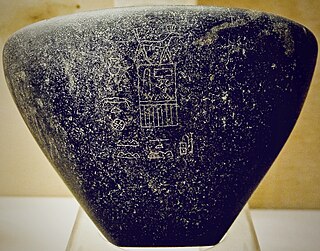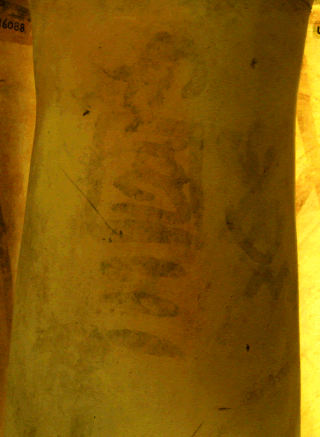Sobek, also known as Suchus, was an ancient Egyptian deity with a complex and elastic history and nature. He is associated with the sacred and Nile crocodiles and is often represented as a crocodile-headed humanoid, if not as a crocodile outright. Sobek was also associated with pharaonic power, fertility, and military prowess, but served additionally as a protective deity with apotropaic qualities, invoked especially for protecting others from the dangers presented by the Nile.

Amenhotep I or Amenophis I, was the second Pharaoh of the 18th Dynasty of Egypt. His reign is generally dated from 1526 to 1506 BC.

Usermaatre Heqamaatre Setepenamun Ramesses IV was the third pharaoh of the Twentieth Dynasty of the New Kingdom of Ancient Egypt. He was the second son of Ramesses III and became crown prince when his elder brother Amenherkhepshef died aged 15 in 1164 BC, when Ramesses was only 12 years old. His promotion to crown prince:
is suggested by his appearance in a scene of the festival of Min at the Ramesses III temple at Karnak, which may have been completed by Year 22 [of his father's reign].

Sobekneferu or Neferusobek was a pharaoh of ancient Egypt and the last ruler of the Twelfth Dynasty of the Middle Kingdom. She ascended to the throne following the death of Amenemhat IV, possibly her brother or husband, though their relationship is unproven. Instead, she asserted legitimacy through her father Amenemhat III. Her reign lasted 3 years, 10 months, and 24 days, according to the Turin King List.

Huni was an ancient Egyptian king, the last pharaoh of the Third Dynasty of Egypt during the Old Kingdom period. Based on the Turin king list, he is commonly credited with a reign of 24 years, ending c. 2613 BC.

Senusret I also anglicized as Sesostris I and Senwosret I, was the second pharaoh of the Twelfth Dynasty of Egypt. He ruled from 1971 BC to 1926 BC, and was one of the most powerful kings of this Dynasty. He was the son of Amenemhat I. Senusret I was known by his prenomen, Kheperkare, which means "the Ka of Re is created." He expanded the territory of Egypt allowing him to rule over an age of prosperity.

Seth-Peribsen is the serekh name of an early Egyptian monarch (pharaoh), who ruled during the Second Dynasty of Egypt. His chronological position within this dynasty is unknown and it is disputed who ruled both before and after him. The duration of his reign is also unknown.

Khasekhemre Neferhotep I was an Egyptian pharaoh of the mid Thirteenth Dynasty ruling in the second half of the 18th century BC during a time referred to as the late Middle Kingdom or early Second Intermediate Period, depending on the scholar. One of the best attested rulers of the 13th Dynasty, Neferhotep I reigned for 11 years.

Khaneferre Sobekhotep IV was one of the more powerful Egyptian kings of the 13th Dynasty, who reigned at least eight years. His brothers, Neferhotep I and Sihathor, were his predecessors on the throne, the latter having only ruled as coregent for a few months.

Sekhemre Khutawy Amenemhat Sobekhotep was an Egyptian pharaoh of the early 13th Dynasty in the late Middle Kingdom.

Sekhemib-Perenma'at, is the Horus name of an early Egyptian king who ruled during the 2nd Dynasty. Similar to his predecessor, successor or co-ruler Seth-Peribsen, Sekhemib is contemporarily well attested in archaeological records, but he does not appear in any posthumous document. The exact length of his reign is unknown and his burial site has yet to be found.

Menwadjre Sihathor was an ephemeral ruler of the 13th Dynasty during the late Middle Kingdom. Sihathor may never have enjoyed an independent reign, possibly only ruling for a few months as a coregent with his brother Neferhotep I.

Sekhemrekhutawy Khabaw was an Egyptian pharaoh of the early 13th Dynasty during the Second Intermediate Period.

Sebkay was an ancient Egyptian pharaoh during the Second Intermediate Period. For a long time his position created problems and he was most often placed into the 13th Dynasty. However, the discovery of the tomb of a king with the name Senebkay make it very likely that Sebkay is identical with the latter and the writing of the name Sebkay is just a misspelling of the name.

S 10 is the modern name given to a monumental ancient Egyptian tomb complex at Abydos in Egypt. The tomb is most likely royal and dates to the mid-13th Dynasty. Finds from nearby tombs indicate that S10 suffered extensive state-sanctioned stone and grave robbing during the Second Intermediate Period, only a few decades after its construction, as well as during the later Roman and Coptic periods. These finds also show that S10 was used for an actual burial and belonged to a king "Sobekhotep", now believed to be pharaoh Sobekhotep IV. According to the Egyptologist Josef W. Wegner who excavated S10, the tomb might originally have been capped by a pyramid, although Aidan Dodson states that it is still unclear whether S10 was a pyramid or a mastaba.

Crocodile is the provisional name of a predynastic ruler, who might have ruled during the late Naqada III epoch. The few alleged ink inscriptions showing his name are drawn very sloppily, and the reading and thus whole existence of king "Crocodile" are highly disputed. His tomb is unknown.
Min was an important Ancient Egyptian courtier of the New Kingdom in office under king Thutmosis III.

Sobekhotep was a local official of the ancient Egyptian New Kingdom under king Amenhotep II. He is known from two statues, one of them is now in Marseilles, the other one in Berlin. On the statues he is holding several titles in connection with the Faiyum Oasis. Most importantly he was mayor of the Faiyum Oasis. He was also overseer of the priests of Sobek, and mayor of the northern and southern lake. He was also bearing the honorific title great one of the Faiyum Oasis. Sobekhotep was also overseer of the treasury.
Hunefer was an ancient Egyptian official under kings Ramses II and Merenptah in the 19th Dynasty around 1225 BC. Hunefer is mainly known from his Theban tomb TT385. Here is also shown his wife Nehty. Hunefer held the title of mayor and was most likely the son of the mayor of Thebes Paser and his wife Tuia. Hunefer is also known from several documents and letters that make it likely that he was still in office under king Merenptah. His huge granite sarcophagus is today at the Fitzwilliam Museum in Cambridge.
Suty was an ancient Egyptian high official under pharaoh Ramesses II. He was overseer of the treasuries – thus responsible for the administration of the commodities coming to the royal palace – and overseer of troops. Suty is known from his decorated tomb at El Khawaled (Mostagedda), in Upper Egypt. He is also known from a sarcophagus that is now in the Cairo Egyptian Museum but most likely comes from this tomb. Shabtis with his name were found in burials of the Apis bulls at Saqqara. They were found close to Apis bulls that were buried in the year 16 and year 30 of the reign of Ramesses II. In year 24 a certain Panehesi was in offices as overseer of the treasuries, before the latter Tia occupied this office, so that Suty must have been in office around year 30 of king Ramesses II. This also indicates that Suty was involved in preparing the burials of these sacred animals. He is also known from several statues.

















